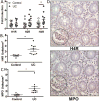Histamine drives severity of innate inflammation via histamine 4 receptor in murine experimental colitis
- PMID: 29363669
- PMCID: PMC5976516
- DOI: 10.1038/mi.2017.121
Histamine drives severity of innate inflammation via histamine 4 receptor in murine experimental colitis
Abstract
Ulcerative colitis (UC) patients exhibit elevated histamine, but how histamine exacerbates disease is unclear as targeting histamine 1 receptor (H1R) or H2R is clinically ineffective. We hypothesized that histamine functioned instead through the other colon-expressed histamine receptor, H4R. In humans, UC patient biopsies exhibited increased H4R RNA and protein expression over control tissue, and immunohistochemistry showed that H4R was in proximity to immunopathogenic myeloperoxidase-positive neutrophils. To characterize this association further, we employed both the oxazolone (Ox)- and dextran sulfate sodium (DSS)-induced experimental colitis mouse models and also found upregulated H4R expression. Mast cell (MC)-derived histamine and H4R drove experimental colitis, as H4R-/- mice had lower symptom scores, neutrophil-recruitment mediators (colonic interleukin-6 (IL-6), CXCL1, CXCL2), and mucosal neutrophil infiltration than wild-type (WT) mice, as did MC-deficient KitW-sh/W-sh mice reconstituted with histidine decarboxylase-deficient (HDC-/-) bone marrow-derived MCs compared with WT-reconstituted mice; adaptive responses remained intact. Furthermore, Rag2-/- × H4R-/- mice had reduced survival, exacerbated colitis, and increased bacterial translocation than Rag2-/- mice, revealing an innate protective antibacterial role for H4R. Taken together, colonic MC-derived histamine initiates granulocyte infiltration into the colonic mucosa through H4R, suggesting alternative therapeutic targets beyond adaptive immunity for UC.
Figures







Similar articles
-
The Function of the Histamine H4 Receptor in Inflammatory and Inflammation-Associated Diseases of the Gut.Int J Mol Sci. 2021 Jun 6;22(11):6116. doi: 10.3390/ijms22116116. Int J Mol Sci. 2021. PMID: 34204101 Free PMC article. Review.
-
In vivo Evidence for Partial Activation of Eosinophils via the Histamine H4-Receptor: Adoptive Transfer Experiments Using Eosinophils From H4R-/- and H4R+/+ Mice.Front Immunol. 2018 Sep 25;9:2119. doi: 10.3389/fimmu.2018.02119. eCollection 2018. Front Immunol. 2018. PMID: 30319608 Free PMC article.
-
Mouse Colonic Epithelial Cells Functionally Express the Histamine H4 Receptor.J Pharmacol Exp Ther. 2020 May;373(2):167-174. doi: 10.1124/jpet.119.264408. Epub 2020 Feb 6. J Pharmacol Exp Ther. 2020. PMID: 32029576
-
Mast Cells Infiltrating Inflamed or Transformed Gut Alternatively Sustain Mucosal Healing or Tumor Growth.Cancer Res. 2015 Sep 15;75(18):3760-70. doi: 10.1158/0008-5472.CAN-14-3767. Epub 2015 Jul 23. Cancer Res. 2015. PMID: 26206557
-
The Role of Histamine and Histamine Receptors in Mast Cell-Mediated Allergy and Inflammation: The Hunt for New Therapeutic Targets.Front Immunol. 2018 Aug 13;9:1873. doi: 10.3389/fimmu.2018.01873. eCollection 2018. Front Immunol. 2018. PMID: 30150993 Free PMC article. Review.
Cited by
-
The Function of the Histamine H4 Receptor in Inflammatory and Inflammation-Associated Diseases of the Gut.Int J Mol Sci. 2021 Jun 6;22(11):6116. doi: 10.3390/ijms22116116. Int J Mol Sci. 2021. PMID: 34204101 Free PMC article. Review.
-
Role of cytochrome P450 polymorphisms and functions in development of ulcerative colitis.World J Gastroenterol. 2019 Jun 21;25(23):2846-2862. doi: 10.3748/wjg.v25.i23.2846. World J Gastroenterol. 2019. PMID: 31249444 Free PMC article. Review.
-
Multi-omics analysis reveals the interaction of gut microbiome and host microRNAs in ulcerative colitis.Ann Med. 2023;55(2):2261477. doi: 10.1080/07853890.2023.2261477. Epub 2023 Sep 29. Ann Med. 2023. PMID: 37774039 Free PMC article.
-
Krill Oil and Its Bioactive Components as a Potential Therapy for Inflammatory Bowel Disease: Insights from In Vivo and In Vitro Studies.Biomolecules. 2024 Apr 6;14(4):447. doi: 10.3390/biom14040447. Biomolecules. 2024. PMID: 38672464 Free PMC article. Review.
-
Role of Mast Cells in Eosinophilic Gastrointestinal Diseases.Immunol Allergy Clin North Am. 2024 May;44(2):311-327. doi: 10.1016/j.iac.2024.01.004. Epub 2024 Feb 19. Immunol Allergy Clin North Am. 2024. PMID: 38575226 Free PMC article. Review.
References
-
- de Souza HS, Fiocchi C. Immunopathogenesis of IBD: current state of the art. Nat Rev Gastroenterol Hepatol. 2016;13(1):13–27. - PubMed
-
- Fumery M, Duricova D, Gower-Rousseau C, Annese V, Peyrin-Biroulet L, Lakatos PL. Review article: the natural history of paediatric-onset ulcerative colitis in population-based studies. Aliment Pharmacol Ther. 2016;43(3):346–355. - PubMed
-
- Romano C, Syed S, Valenti S, Kugathasan S. Management of Acute Severe Colitis in Children With Ulcerative Colitis in the Biologics Era. Pediatrics. 2016;137(5) - PubMed
Publication types
MeSH terms
Substances
Grants and funding
LinkOut - more resources
Full Text Sources
Other Literature Sources
Medical
Molecular Biology Databases
Research Materials

